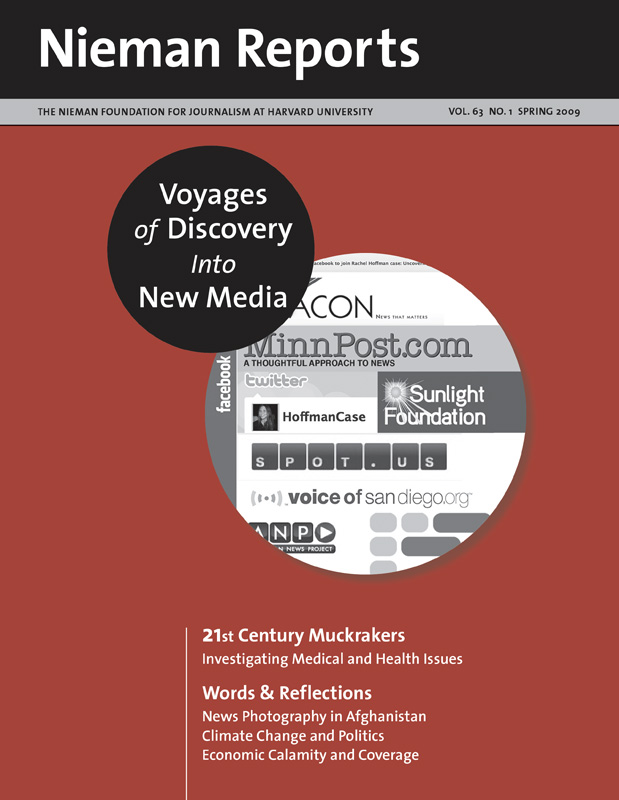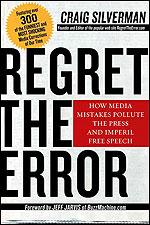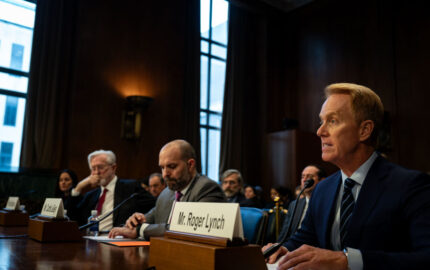
Voyages of Discovery Into New Media
At the crossroad of old journalism and new media, digital news entrepreneurs lead us on voyages of discovery into new media. From MinnPost to MediaStorm, these entities are using visual media, interactivity and social media to watchdog government abuse and the justice system, identify environmental dangers, and tell enduring stories. In doing so, they illuminate possibilities.
For more than 100 years, one of the most recognizable slogans in journalism has been “All the News That’s Fit to Print.” Lately, The New York Times motto is being challenged by the familiar phrase, “do more with less.” This new saying was, in fact, the theme of the World Editors Forum scheduled for March, but the event had to be cancelled “due to the impact of the global financial downturn on newspaper companies.”
News organizations are shedding employees. Those that remain are expected to pick up the slack and also push ahead with digital initiatives. Included in the exodus are valuable copyeditors—the people in whose encyclopedic brains reside a lot of what prevents errors from surfacing in stories. The few, the proud—and disappearing—magazine fact checkers are also being told to grab their World Almanacs and Book of Facts and move along.
Accuracy is a huge journalistic challenge. When reporters are asked to take on more work while the newsroom’s same fallible processes and error-prone technologies remain in place, the result will undoubtedly be a further downward slide in quality. More errors will be followed by more apologies and more corrections. And this is happening at a critical time for journalism—a time when consumers are being asked by journalists using digital media to lend support to their newsgathering mission.
How much will accuracy in news reporting be worth to them?
The Orlando Sentinel already confronted this issue. Following a round of staff reductions in the fall of 2007, Manning Pynn, the Sentinel’s public editor, highlighted how the paper’s accuracy had been affected. “In the past three months, the newspaper has corrected more than a third more errors of its own making on average than it did during the relatively placid prior five months,” he wrote.
The cause was obvious. “When the Sentinel tightened its financial belt back in June, it lost a wealth of seasoned veterans, many of them editors,” Pynn wrote. “Those journalists not only wrote headlines and captions. They also scrutinized the work of reporters—correcting spelling, straightening out syntax, double-checking facts—before publication. With fewer people to do that now, less of that important work gets done, and the result is more published errors.”
Pynn also found a link between quality and financial survival. “Every business’s success depends on the reliability of its products or services,” he observed. “If their reliability declines, people are less likely to buy them. Newspapers are particularly susceptible to that phenomenon.”
Quality: What Does It Mean?
Four years of researching and writing about press errors and corrections have led me to a surprising conclusion: A file cabinet is a beautiful thing. Allow me to explain. Open more than one drawer and a file cabinet tends to tip over. Solution: Allow only one drawer to be opened at a time. The humble file cabinet comes to mind whenever I read a correction of a misspelled name, incorrect date, or other highly preventable error. If we could develop simple ways of preventing journalistic missteps, we’d all be better off.
In the digital age, we have plenty of tools that make us more productive and others that supposedly help us to eliminate mistakes. Yet it turns out that some of those tools—such as the spell checker—introduce as many errors as they might help us to correct. For example, the Daily Post in Liverpool, England published a correction noting that, “The computer spell checker did not recognize the term WNO (Welsh National Opera). A slip of the finger caused it to be replaced with the word ‘winos.’”
So it’s left to another error-prone tool—the human brain—to recognize that “winos” has no business being there. It’s our last line of defense, but one too seldom used these days. We know this because accuracy studies of American newspapers conducted during the past seven decades have found that between 40 and 60 percent of news stories have some type of mistake, such as a misspelled name or a quote taken out of context. And when mistakes happen, a landmark 2007 study by Scott Maier at the University of Oregon revealed that fewer than two percent of news stories identified as factually errant resulted in published corrections.
Too many mistakes—with far too few corrections published—amounts to a woeful lack of quality control for journalism. Yet the word “quality” still surfaces often in discourse about our profession. “High-quality journalism is threatened, and it may not be able to continue unless we can convince people that they need to support high-quality journalism on the Web with their own dollars and cents,” Philip S. Balboni, a cofounder of GlobalPost.com, an international news Web site, told The Boston Globe in January.
In a February chat with New York Times readers, executive editor Bill Keller said there is “a diminishing supply of quality journalism and a growing demand. By quality journalism I mean the kind that involves experienced reporters going places, bearing witness, digging into records, developing sources, checking and double-checking, backed by editors who try to enforce high standards.”
Eliminating Errors
How the words “quality” and “journalism” fit together presents a different kind of puzzle for those who are not journalists. The American Society for Quality, for example, puts forth two definitions of quality: “the characteristics of a product or service that bear on its ability to satisfy stated or implied needs” or “a product or service free of deficiencies.” And Six Sigma, which certifies if something is of quality, measures its presence by using a formula that calculates the number of defects per million opportunities.
When these definitions and measuring tools are applied to journalism, the quest for quality would begin with the elimination of the vast majority of preventable factual errors. In a 2004 speech, John Carroll, a former editor of the Los Angeles Times, compared errors made in the newspaper to industrial pollution: “Like a factory on a river, daily journalism is an industry that produces pollution. Our pollution comes in the form of errors. America’s river of public discourse—if I may extend this figure of speech—is polluted by our mistakes.” His bottom line and mine: Errors are a sign of a low quality product. By correcting errors, Carroll said, “A good newspaper cleans up after itself.”
Yes, but quality journalism ought first to be dedicated to preventing them. And that is not what is happening today. For help figuring out how to do this, John R. Grout, an associate professor at the Campbell School of Business at Berry College in Georgia, is a logical person to turn to. Grout is an expert in poka-yoke, the Japanese discipline of mistake proofing, in which the goal is to create processes and products that eliminate potential for error. Poka-yoke is used in nuclear power plants, aviation, manufacturing and health care.
What about journalism? “It’s a new application for me,” Grout told me when I spoke with him as part of my research for my 2007 book, “Regret the Error: How Media Mistakes Pollute the Press and Imperil Free Speech.” As he put it, “My concern is that a lot of it [journalism] is creative, where you are creating something one time and one time only …. Still, there’s a whole set of other aspects where the process is very repeatable and routine.”
In no time at all, Grout was imagining a digital tool that would highlight proper names, dates, ages, genders and other verifiable facts as they were entered on a page. The system would check them against a central database maintained and updated by the news organization. It could, for example, alert reporters that it’s Edgar Allan Poe, not Edgar Allen Poe. This system would also make sure that spelling and facts are consistent in the headline and article. It could even require reporters input source material for facts and quotes, thereby forcing reporters to record their source material and enabling an editor to perform a quick fact check.
The Human Factor
For Grout, coming up with a design solution was a natural direction in which to head. Still, the human factor needs to be addressed, so I turned to the American Society for Quality in the hope of finding someone who’d applied quality techniques to an editorial process. I was referred to Grace Duffy, coauthor of “The Quality Improvement Handbook,” who has the highest quality ranking in her field, Certified Lean Six Sigma Master Black Belt. Best of all, she’d developed quality processes for highly sensitive projects that required documentation.
If spelling someone’s name wrong ranks as a terrible mistake for journalists—and, for the record, it is—then writing documentation for a safety console at a nuclear reactor clearly prepares one to offer some lessons. Her first one: Quality must be made a part of an organization’s culture through establishing clearly defined incentives. “If the culture says there is no excuse for errors and says I will do my very best because the audience deserves it, then you will find people giving that extra bit of checking,” she said. But if the system rewards other things, then “it might be worth it to a writer not to find errors, because they might be more rewarded if they meet a deadline or get a scoop.”
For accuracy to rise to the top, the editorial process has to be broken into smaller steps to highlight how errors occur. Once identified, they can be eliminated or at least reduced by developing new processes and training programs. Another key aspect of quality is data collection; mistakes are essential data, and they need to be tracked and logged so that a clear picture of where, why and how they occur emerges. Some news organizations have corrections databases that track the details of every known mistake. Unfortunately, such organizations are the exception.
When I asked Duffy if it is good policy to discipline reporters and editors who make errors, she replied: “Establish expectations clearly before creating sanctions …. Don’t just fire people or beat them about the head—give them time to work through the concept.”
Even when accuracy is espoused, policies need to be put into action in a consistent and measurable way. Only then does quality become a tangible part of an organization—something that can be measured, improved upon, and clearly communicated to staff and the public. Can such quality techniques work for journalism? “There’s no doubt at all,” Duffy said, as long as the impetus to do so exists.
As new models of Web-based journalism emerge, verification strategies and new models to prevent errors are essential. Keeping errors to a minimum will be key to the success of digital journalism. By doing this, Web news operations will convince the public to turn to and support their publication as this factor is likely to play a determinative role in which Web sites consumers will turn to for reliable information.
Craig Silverman is the author of “Regret the Error: How Media Mistakes Pollute the Press and Imperil Free Speech,” published by Union Square Press in 2007 and now available in paperback by Sterling Publishing.
News organizations are shedding employees. Those that remain are expected to pick up the slack and also push ahead with digital initiatives. Included in the exodus are valuable copyeditors—the people in whose encyclopedic brains reside a lot of what prevents errors from surfacing in stories. The few, the proud—and disappearing—magazine fact checkers are also being told to grab their World Almanacs and Book of Facts and move along.
Accuracy is a huge journalistic challenge. When reporters are asked to take on more work while the newsroom’s same fallible processes and error-prone technologies remain in place, the result will undoubtedly be a further downward slide in quality. More errors will be followed by more apologies and more corrections. And this is happening at a critical time for journalism—a time when consumers are being asked by journalists using digital media to lend support to their newsgathering mission.
How much will accuracy in news reporting be worth to them?
The Orlando Sentinel already confronted this issue. Following a round of staff reductions in the fall of 2007, Manning Pynn, the Sentinel’s public editor, highlighted how the paper’s accuracy had been affected. “In the past three months, the newspaper has corrected more than a third more errors of its own making on average than it did during the relatively placid prior five months,” he wrote.
The cause was obvious. “When the Sentinel tightened its financial belt back in June, it lost a wealth of seasoned veterans, many of them editors,” Pynn wrote. “Those journalists not only wrote headlines and captions. They also scrutinized the work of reporters—correcting spelling, straightening out syntax, double-checking facts—before publication. With fewer people to do that now, less of that important work gets done, and the result is more published errors.”
Pynn also found a link between quality and financial survival. “Every business’s success depends on the reliability of its products or services,” he observed. “If their reliability declines, people are less likely to buy them. Newspapers are particularly susceptible to that phenomenon.”
Quality: What Does It Mean?
Four years of researching and writing about press errors and corrections have led me to a surprising conclusion: A file cabinet is a beautiful thing. Allow me to explain. Open more than one drawer and a file cabinet tends to tip over. Solution: Allow only one drawer to be opened at a time. The humble file cabinet comes to mind whenever I read a correction of a misspelled name, incorrect date, or other highly preventable error. If we could develop simple ways of preventing journalistic missteps, we’d all be better off.
In the digital age, we have plenty of tools that make us more productive and others that supposedly help us to eliminate mistakes. Yet it turns out that some of those tools—such as the spell checker—introduce as many errors as they might help us to correct. For example, the Daily Post in Liverpool, England published a correction noting that, “The computer spell checker did not recognize the term WNO (Welsh National Opera). A slip of the finger caused it to be replaced with the word ‘winos.’”
So it’s left to another error-prone tool—the human brain—to recognize that “winos” has no business being there. It’s our last line of defense, but one too seldom used these days. We know this because accuracy studies of American newspapers conducted during the past seven decades have found that between 40 and 60 percent of news stories have some type of mistake, such as a misspelled name or a quote taken out of context. And when mistakes happen, a landmark 2007 study by Scott Maier at the University of Oregon revealed that fewer than two percent of news stories identified as factually errant resulted in published corrections.
Too many mistakes—with far too few corrections published—amounts to a woeful lack of quality control for journalism. Yet the word “quality” still surfaces often in discourse about our profession. “High-quality journalism is threatened, and it may not be able to continue unless we can convince people that they need to support high-quality journalism on the Web with their own dollars and cents,” Philip S. Balboni, a cofounder of GlobalPost.com, an international news Web site, told The Boston Globe in January.
In a February chat with New York Times readers, executive editor Bill Keller said there is “a diminishing supply of quality journalism and a growing demand. By quality journalism I mean the kind that involves experienced reporters going places, bearing witness, digging into records, developing sources, checking and double-checking, backed by editors who try to enforce high standards.”
Eliminating Errors
How the words “quality” and “journalism” fit together presents a different kind of puzzle for those who are not journalists. The American Society for Quality, for example, puts forth two definitions of quality: “the characteristics of a product or service that bear on its ability to satisfy stated or implied needs” or “a product or service free of deficiencies.” And Six Sigma, which certifies if something is of quality, measures its presence by using a formula that calculates the number of defects per million opportunities.
When these definitions and measuring tools are applied to journalism, the quest for quality would begin with the elimination of the vast majority of preventable factual errors. In a 2004 speech, John Carroll, a former editor of the Los Angeles Times, compared errors made in the newspaper to industrial pollution: “Like a factory on a river, daily journalism is an industry that produces pollution. Our pollution comes in the form of errors. America’s river of public discourse—if I may extend this figure of speech—is polluted by our mistakes.” His bottom line and mine: Errors are a sign of a low quality product. By correcting errors, Carroll said, “A good newspaper cleans up after itself.”
Yes, but quality journalism ought first to be dedicated to preventing them. And that is not what is happening today. For help figuring out how to do this, John R. Grout, an associate professor at the Campbell School of Business at Berry College in Georgia, is a logical person to turn to. Grout is an expert in poka-yoke, the Japanese discipline of mistake proofing, in which the goal is to create processes and products that eliminate potential for error. Poka-yoke is used in nuclear power plants, aviation, manufacturing and health care.
What about journalism? “It’s a new application for me,” Grout told me when I spoke with him as part of my research for my 2007 book, “Regret the Error: How Media Mistakes Pollute the Press and Imperil Free Speech.” As he put it, “My concern is that a lot of it [journalism] is creative, where you are creating something one time and one time only …. Still, there’s a whole set of other aspects where the process is very repeatable and routine.”
In no time at all, Grout was imagining a digital tool that would highlight proper names, dates, ages, genders and other verifiable facts as they were entered on a page. The system would check them against a central database maintained and updated by the news organization. It could, for example, alert reporters that it’s Edgar Allan Poe, not Edgar Allen Poe. This system would also make sure that spelling and facts are consistent in the headline and article. It could even require reporters input source material for facts and quotes, thereby forcing reporters to record their source material and enabling an editor to perform a quick fact check.
The Human Factor
For Grout, coming up with a design solution was a natural direction in which to head. Still, the human factor needs to be addressed, so I turned to the American Society for Quality in the hope of finding someone who’d applied quality techniques to an editorial process. I was referred to Grace Duffy, coauthor of “The Quality Improvement Handbook,” who has the highest quality ranking in her field, Certified Lean Six Sigma Master Black Belt. Best of all, she’d developed quality processes for highly sensitive projects that required documentation.
If spelling someone’s name wrong ranks as a terrible mistake for journalists—and, for the record, it is—then writing documentation for a safety console at a nuclear reactor clearly prepares one to offer some lessons. Her first one: Quality must be made a part of an organization’s culture through establishing clearly defined incentives. “If the culture says there is no excuse for errors and says I will do my very best because the audience deserves it, then you will find people giving that extra bit of checking,” she said. But if the system rewards other things, then “it might be worth it to a writer not to find errors, because they might be more rewarded if they meet a deadline or get a scoop.”
For accuracy to rise to the top, the editorial process has to be broken into smaller steps to highlight how errors occur. Once identified, they can be eliminated or at least reduced by developing new processes and training programs. Another key aspect of quality is data collection; mistakes are essential data, and they need to be tracked and logged so that a clear picture of where, why and how they occur emerges. Some news organizations have corrections databases that track the details of every known mistake. Unfortunately, such organizations are the exception.
When I asked Duffy if it is good policy to discipline reporters and editors who make errors, she replied: “Establish expectations clearly before creating sanctions …. Don’t just fire people or beat them about the head—give them time to work through the concept.”
Even when accuracy is espoused, policies need to be put into action in a consistent and measurable way. Only then does quality become a tangible part of an organization—something that can be measured, improved upon, and clearly communicated to staff and the public. Can such quality techniques work for journalism? “There’s no doubt at all,” Duffy said, as long as the impetus to do so exists.
As new models of Web-based journalism emerge, verification strategies and new models to prevent errors are essential. Keeping errors to a minimum will be key to the success of digital journalism. By doing this, Web news operations will convince the public to turn to and support their publication as this factor is likely to play a determinative role in which Web sites consumers will turn to for reliable information.
Craig Silverman is the author of “Regret the Error: How Media Mistakes Pollute the Press and Imperil Free Speech,” published by Union Square Press in 2007 and now available in paperback by Sterling Publishing.



